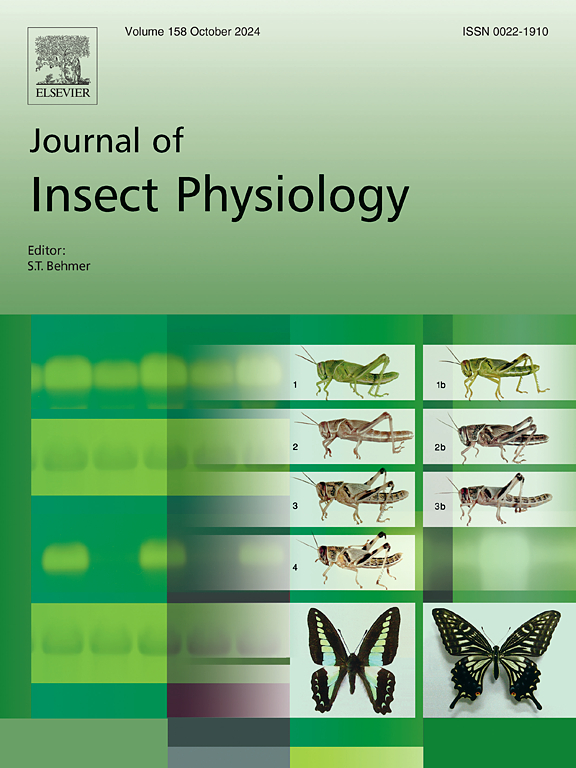双链RNA外用递送法在长鼻红蝇唾液基因沉默中的应用评价
IF 2.3
2区 农林科学
Q1 ENTOMOLOGY
引用次数: 0
摘要
RNA干扰(RNA interference, RNAi)技术已广泛应用于害虫防治和基因组学研究中,可有效靶向Triatominae的唾液腺和中肠等组织中的基因。本研究评估了外用dsRNA作为一种靶向长绿红牙唾液基因、硝基磷蛋白2 (NP2)和一氧化氮合酶(NOS)的递送方法的有效性。将丙酮稀释的dsRNA(1:1)应用于若虫的背侧,成功触发RNAi,在保持dsRNA完整性的同时实现了跨横向mRNA的还原。实时定量聚合酶链反应(qPCR)分析显示,NP2 mRNA水平在N2至N5期显著降低(72%至95.6%),其他硝基磷蛋白(NP1-NP4)无脱靶效应,证实了沉默的特异性。同样,NOS敲除使mRNA水平在N1至N5期降低47.9%至91.0%。这些减少伴随着唾液腺可见的颜色变化,一种通过图像分析验证的表型。功能分析进一步表明,NP2沉默缩短了血浆凝固时间,而NOS敲低降低了no结合的硝基磷的比例。与显微注射相比,在N3中局部应用2.5µg dsRNA (NP2或NOS)在降低mRNA水平(qPCR)和改变昆虫表型(血浆再钙化时间或分光光度法分析)方面的效果较差。虽然不如显微注射有效,但局部应用作为一种给药方法有其优点:它避免了对昆虫的物理伤害,简化了对较小若虫的应用,并为研究免疫相关基因提供了一种实用的选择。这些发现强调了局部RNAi作为一种非侵入性的、有效的功能基因组研究工具的潜力,特别是针对唾液腺靶点。本文章由计算机程序翻译,如有差异,请以英文原文为准。

Evaluation of topical application as a delivery method of double-stranded RNA in Rhodnius prolixus (Hemiptera, Triatominae) for salivary gene silencing
RNA interference (RNAi) techniques have been widely applied in insect pest control and genomics research, effectively targeting genes in tissues like salivary glands and the midgut in Triatominae. This study evaluated the efficacy of topical application as a delivery method for dsRNA targeting Rhodnius prolixus salivary genes, Nitrophorin 2 (NP2), and Nitric Oxide Synthase (NOS). Applying dsRNA diluted in acetone (1:1) to the dorsal side of nymphs successfully triggered RNAi, achieving transstadial mRNA reduction while preserving dsRNA integrity. Real-time quantitative polymerase chain reaction (qPCR) analysis showed significant reductions on mRNA levels of NP2 (72 % to 95.6 %) across N2 to N5 stages, with no off-target effects in other nitrophorins (NP1–NP4), confirming silencing specificity. Similarly, NOS knockdown reduced mRNA levels by 47.9 % to 91.0 % across N1 to N5 stages. These reductions were accompanied by visible color changes in salivary glands, a phenotype validated through image analysis. Functional assays further demonstrated that NP2 silencing shortened plasma coagulation time, while NOS knockdown reduced the proportion of NO-bound nitrophorins. Compared to microinjection, the topical application of 2.5 µg of dsRNA (NP2 or NOS) in N3 was less effective in reducing mRNA levels (qPCR) as well as in altering insect phenotypes (plasma recalcification time or spectrophotometry analysis). Although less efficient than microinjection, topical application as a delivery method offers advantages: it avoids physical damage to insects, simplifies application for smaller nymphs, and provides a practical alternative for studying immune-related genes. These findings highlight the potential of topical RNAi as a non-invasive, effective tool for functional genomic studies in Triatominae, particularly for salivary gland targets.
求助全文
通过发布文献求助,成功后即可免费获取论文全文。
去求助
来源期刊

Journal of insect physiology
生物-昆虫学
CiteScore
4.50
自引率
4.50%
发文量
77
审稿时长
57 days
期刊介绍:
All aspects of insect physiology are published in this journal which will also accept papers on the physiology of other arthropods, if the referees consider the work to be of general interest. The coverage includes endocrinology (in relation to moulting, reproduction and metabolism), pheromones, neurobiology (cellular, integrative and developmental), physiological pharmacology, nutrition (food selection, digestion and absorption), homeostasis, excretion, reproduction and behaviour. Papers covering functional genomics and molecular approaches to physiological problems will also be included. Communications on structure and applied entomology can be published if the subject matter has an explicit bearing on the physiology of arthropods. Review articles and novel method papers are also welcomed.
 求助内容:
求助内容: 应助结果提醒方式:
应助结果提醒方式:


